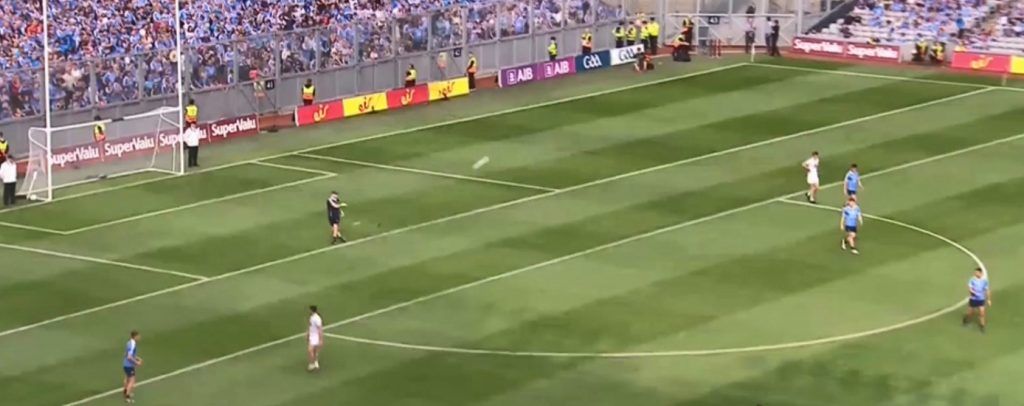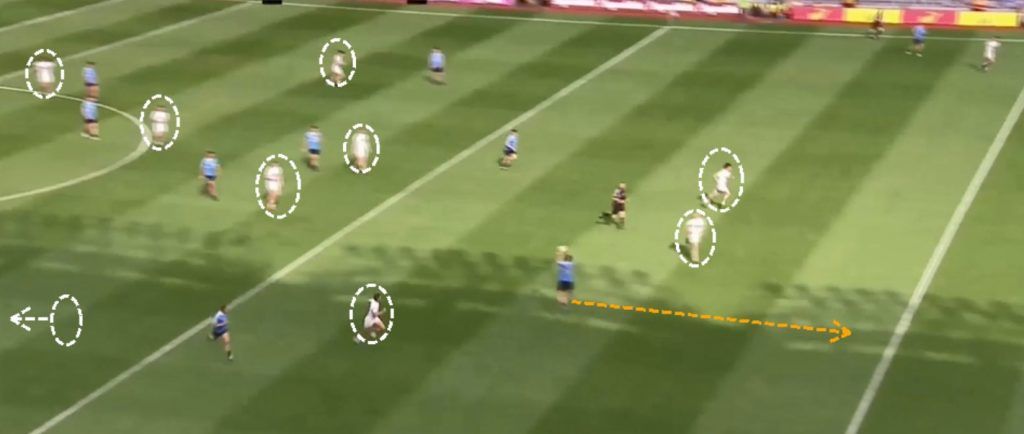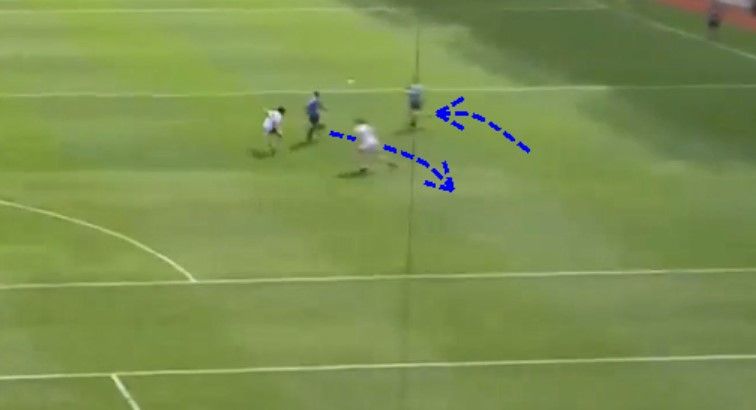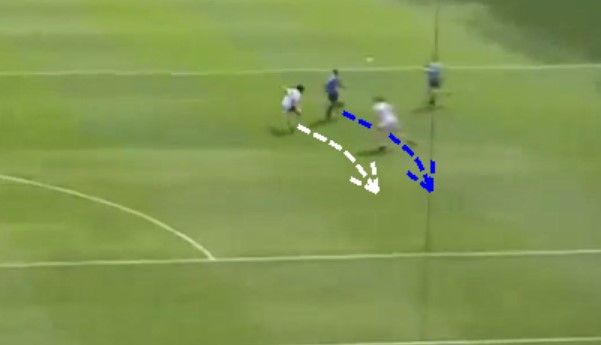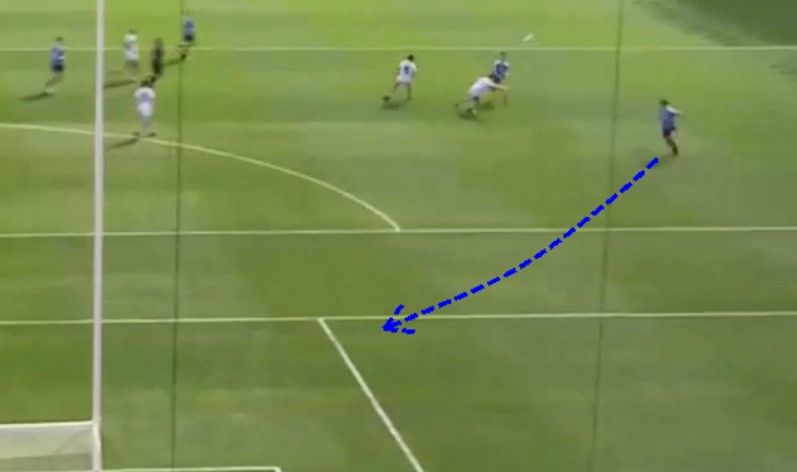Another Dublin win at a canter and another textbook performance of attacking brilliance, but some question marks defensively raised their heads, once again.
We previously examined how Carlow had asked some difficult questions of the three-in-a-row chasing Dubs and Westmeath even managed to make things difficult – in specific areas – and Sunday’s Leinster final was far from a perfect outing for the history-makers from the capital.
Dublin Kick-outs
As ever, the cornerstone of Jim Gavin’s tactics proved to be Stephen Cluxton’s restarts. From start to finish they got off a total of 12 quick kick-outs and scored seven points from them. They scored four from six kicked to the full-back line (inside 9.5 seconds), one from one to the half-back line (inside 11.5 seconds) and two from five to midfield (inside 12 seconds).
As ever, the value of sides like Mayo who have broadly choked off this source, particularly to the full-back line, was illustrated.
It’s a quick kick-out
Taking out nine Kildare men and leading to a point
Kildare Kick-outs
Once again, however, Dublin’s record on the opposition’s kick-outs should be cause for concern. Untypically, they were crucified on primary possession on Kildare’s long kicks, losing 16 and winning just seven.
Considering Kildare didn’t get any of these off quickly, it does potentially raise alarm bells, though Mark Donnellan’s accuracy deserves huge credit. Saying that, Kildare only managed to turn three of those into points, a 19 percent kick won to point ratio.
On the other hand, Dublin, as ever, crucified their opposition when they won their long kick-outs, scoring 1-2 from the seven won, a whopping 71 percent kick-out won to point ratio.
So, in total, despite a heavy loss in straight up win/loss on the opposition’s long kick-outs, Dublin actually grossed 0.09 of point profit per long Kildare kick-out. That was on a day where they lost more than two to one!
Dublin’s Key Weakness
The same concerning pattern for Dublin which keeps on popping its head up arose again. Kildare got off just six kick-outs to the full back line, and only one of them quickly.
Following on from a 50 percent short kick-out to score concession ratio to Kerry last year, 100 percent in the league final this year and a 100 percent score concession/scoreable free conceded ratio against Carlow in the Leinster opener, Dublin once again shipped heavily on the opposition’s short kick-outs, even where they weren’t kicked quickly.
Kildare played five (not quick) and scored 1-2. That’s another 100 percent concession ratio and very definitely alludes to the key strategy for any side who want to beat Dublin. Kildare also scored a point off the only one they hit quickly.
Dublin had their whole team behind the ball for the kick-out which led to Kildare’s goal
Saying that, Dublin did score one goal upon the initial turnover from a short Kildare kick-out, so Kildare’s gross value on the short kicks was 0.5 points per kick.
In total, however, in keeping with all broader recent Dublin patterns, the difference in expected value between Kildare going short and going long is an “Expected Value” of 0.59 of a point per kick.
All sides who fancy toppling the Dubs should be working on getting off the short kick-out at all costs!
Zonal Defence Analysis
There was one startling figure relating to the manner in which both sides attacked which is that Kildare actually created more man-on-man attacks than Dublin did.
The more startling figure, however, is that from the 11 they created they only scored two points, an 18 percent attack to point ratio. From the eight which Dublin manoeuvred they scored seven points, an 88 percent attack to score ratio.
In short Dublin’s capacity to attack lethally was the difference. There was, however, a massively significant, yet subtle, element relating to each side’s attacks.
Dublin’s attacking methodology
Is it a coincidence that Kildare have followed on from Cork’s form against Kerry in having radically higher scoring figures where they’ve attacked slowly rather than quickly? Perhaps not!
Taking a look at a particular piece of analysis you’ll see that Dublin’s attacking prowess is not just based on immense raw ability, but on immense structure and intelligence too.
In lay man’s terms, we’ve looked at each sides’ attacks which involved a man taking the ball off the shoulder at pace, at an angle, compared with those which didn’t.
In more scientific terms, the parameters are attacks which comprised of a man receiving a hand-pass at no less than three-quarter pace, at between a 65 and 115 degree angle (within 25 degrees of perpendicular), while moving forward in the opposition’s half (or making that run and receiving the ball directly afterwards), or in a position where they received the pass at the same angle while running away from goal but directly into a shooting position.
There are a plethora of advantages to this style of attacking towards the corner and handing the ball off. They range from giving defenders enough rope to hang themselves by following the ball and not their man (like for both Dublin goals), to forwards kicking points just after receiving the ball, unopposed, as opposed to after out-sprinting a defender and being under pressure.
The figures are startling. Dublin had 48 attacks in total compared with Kildare’s 46, but Dublin attacked in this manner 22 times, while Kildare did so 17 times.
Let’s look at Dublin’s totals first. Excluding attacks where the ball was turned over high up the field or where an opposition defender gave away an unnecessary free, Dublin’s ratio when they didn’t attack in the aforementioned manner was the following.
Nine attacks didn’t result in a shot, eight resulted in a failed shot and seven in points. That’s a 29 percent attack to point ratio.
From 22 attacks which fitted the previous parameters, they failed to get a shot off just once, they failed to convert a shot five times and they scored 2-14. That’s a 91 percent point to attack ratio!
James McCarthy comes off the shoulder of Paddy Andrews at an angle
David Slattery should follow McCarthy but goes to the ball
Allowing McCarthy a clear run to goal
Kildare by contrast, from 26 attacks when not applying the aforementioned method, failed to get a shot off 14 times, failed to convert seven times and scored 1-4. That’s a 27 percent attack to point ratio.
From 17 attacks which fitted those parameters, they failed to get a shot off just three times, they failed to convert five times and they scored nine points. That’s a 53 percent attack to point ratio!
Conclusion
The manner in which Dublin now attack is probably as structurally efficient as the game has ever seen. Even where they create man-on-man attacks, typically, they will head for the corner and hand the ball off to a player coming off the shoulder at some point.
It’s a massive shift from Dublin’s pre-2015 style which relied heavily on breakneck speed attacks, and makes them a formidable attack for even the best of defences.
Any side who plan to topple them will need to plan for this element and make their defensive structures as rigid as rigid can be. That, as well as getting off short kick-outs and attacking Dublin from deep, their one chronic weakness.
Stephen O’Meara is the creator and owner of www.gaaprostats.com, statistical and video analysis software designed specifically for Gaelic football and hurling.

